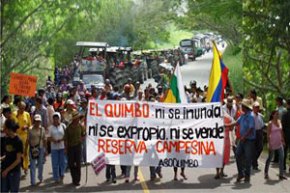Thousands of illegal gold miners battled police for control of a regional capital in the Amazon basin on Wednesday and at least three people were killed by gunfire. 
Outnumbered riot police fired tear gas against miners who wielded clubs and rocks and tried to seize strategic facilities in Puerto Maldonado. The miners are fighting government efforts to regulate small-scale gold extraction, which is ravaging the rain forest, contaminating it with tons of mercury.
Interior Ministry spokesman Victor Calderon said it was unclear whether police fired directly on rioters in Puerto Maldonado, a boomtown at the confluence of two jungle rivers in a region popular with ecotourists.
After talks failed with a government delegation, at least 12,500 miners had attempted to seize public buildings, markets and the airport in the city, said Madre de Dios regional President Jose Luis Aguirre.
“The situation is untenable. You can hear gunshots throughout the entire city,” he told The Associated Press by phone, calling the situation “out of control.”
Three people were killed by gunfire, said regional health director Dr. Jorge Asencios, and 38 were treated at Santa Rosa regional hospital for injuries, including a police officer hit in the head by a rock.
Asencios said 10 of the wounded would be airlifted to Lima, the capital, for treatment.
Interior Minister Daniel Lozada said in a TV interview that some miners “were armed, even with explosives … and obviously police had to act to maintain order.”
He said police made 62 arrests and that nine officers were among the injured. By afternoon, 500 police reinforcements had arrived to bolster a badly outnumbered contingent of 700 officers.
Police said they prevented rioters from seizing the bus station and airport of the largely dirt-street capital of about 37,000 residents. But to the west, miners took control of a key bridge, blocking the transoceanic highway that links the highland city of Cuzco and Peru’s coast to Brazil.
“Everyone is frightened. The few government offices that are functioning are working with doors shut,” said Oscar Guadalupe, an activist who works with victims of child prostitution in the largely lawless region.
Protesters piled rocks and garbage on street corners and residents stayed home behind locked doors. Streets normally buzzing with motorcycle taxis were empty.
A gold rush has swelled Madre de Dios state with about 40,000 small-scale miners who are scarring virgin rain forest as they extract gold particles from river beds and alluvial plains. Mercury is used to bind the gold together in nuggets.
The gold fever has been fueled by a tripling in the price of the precious metal over the past decade.
It has attracted poor farmers from the Andean highlands as well as unscrupulous investors and gunslingers, and Madre de Dios now produces about a fifth of Peru’s overall annual gold yield.
The mining is almost entirely illegal and government attempts to regulate it have been mostly futile, not just in Madre de Dios but in other regions where informal mining is also rampant.
Informal miners also held protests Wednesday in at least two other regions, Piura in Peru’s northwest and Puno in the southern highlands bordering Bolivia.
A government commission led by the environment minister was in Puerto Maldonado on Monday to discuss legalizing the mining activity. But most informal mining leaders walked out after their request to increase their delegation’s size was turned down, said Humberto Cordero, a local environment ministry official.
One mining leader, Miguel Herrera, accused the government of aiming not to legalize but to destroy small-scale mining.
“Mining gives work to lots of people,” he said. “Many families depend on mining and would be without sustenance without it.”
Four recent government decrees have sought to regulate mining to protect the environment and capture tax revenues, said Cordero, who denied the government is trying to end all informal mining.
“In no way is there a desire to end mining activity as such as some mining leaders are misinforming,” he said.
The government’s intent is to end mining in prohibited areas such as buffer zones bordering nature reserves and to allow miners with legally recognized claims to formalize them, Cordero added.
Join Amazon Rainforest on Facebook:
http://www.facebook.com/amazonrainforest








